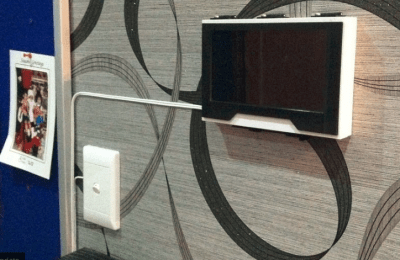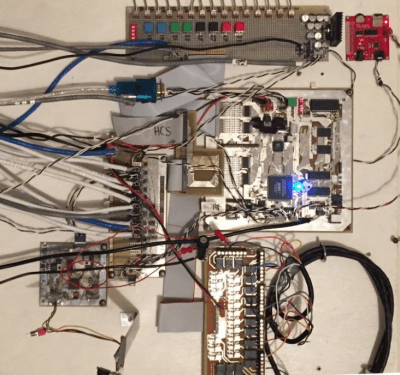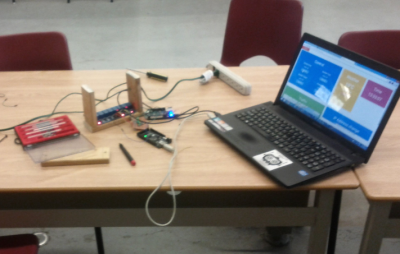Home automation – the idea of a smart home that monitors and controls the inside environment, takes commands from occupants, and generally makes living easier. Hackers, makers, and engineers have been building their own vision of the smart home for decades. Thanks to cell phones and the revolution of the “internet of things”, home automation is now in the public eye. The hackers haven’t stopped though. They’re still building dreams, one circuit and one line of code at a time. This week’s Hacklet is dedicated to some of the best home automation projects on Hackaday.io!
 We start at the top – [IamTeknik’s] Project Jarvis has been in the top five skulled and viewed projects on Hackaday.io for as long as we’ve been keeping records. Just like the fictional Tony Stark design which inspired its name, Jarvis is based on artificial intelligence. [IamTeknik] has created a system using the BeagleBone Black running his own custom software. He’s also creating Jarvis from the ground up – even the relay modules have been designed and built by [IamTeknik]. So far Jarvis has a great 3D printed door lock unit, and a really nice wall mounted tablet. We’re watching to see what modules [IamTeknik] adds next!
We start at the top – [IamTeknik’s] Project Jarvis has been in the top five skulled and viewed projects on Hackaday.io for as long as we’ve been keeping records. Just like the fictional Tony Stark design which inspired its name, Jarvis is based on artificial intelligence. [IamTeknik] has created a system using the BeagleBone Black running his own custom software. He’s also creating Jarvis from the ground up – even the relay modules have been designed and built by [IamTeknik]. So far Jarvis has a great 3D printed door lock unit, and a really nice wall mounted tablet. We’re watching to see what modules [IamTeknik] adds next!
 [Morrisonpiano] is no home automation noob. He’s been running his own system for two decades. HCS_IV Home Automation System is a project to update his HCS_C home automation system. For the uninitiated, the original HCS was created by [Steve Ciarcia] of Byte and Circuit Cellar fame. There have been several generations of the hardware and software since then, with plenty hackers adding their own custom features. [Morrisonpiano] is updating his system with an NXP Arm Cortex M4 CPU, three big Altera Cyclone FPGAs, and plenty of flash storage. Why use a FPGA on a home automation system? I/O of course! HCS uses a ton of I/O. There are 16 RS485 ports and 10 RS232 serial ports. Going with an FPGA makes things flexible as well. Want to add CAN bus? Just drop in some CAN HDL code and you’re golden!
[Morrisonpiano] is no home automation noob. He’s been running his own system for two decades. HCS_IV Home Automation System is a project to update his HCS_C home automation system. For the uninitiated, the original HCS was created by [Steve Ciarcia] of Byte and Circuit Cellar fame. There have been several generations of the hardware and software since then, with plenty hackers adding their own custom features. [Morrisonpiano] is updating his system with an NXP Arm Cortex M4 CPU, three big Altera Cyclone FPGAs, and plenty of flash storage. Why use a FPGA on a home automation system? I/O of course! HCS uses a ton of I/O. There are 16 RS485 ports and 10 RS232 serial ports. Going with an FPGA makes things flexible as well. Want to add CAN bus? Just drop in some CAN HDL code and you’re golden!
[S teven] is giving the smart home more senses with Squirco Smart Home System – Sensor Network. Rather than just have a temperature sensor at the thermostat, or a motion detector in the front foyer, [Steven] wants a network of unobtrusive sensors to blanket the home. He’s doing this by replacing the common light switch with a smart module that has sensors for temperature, humidity, and human presence. [Steven] has spent quite a bit of time researching and experimenting microwave tomography as a means to detect humans. Going with microwaves means no obvious PIR windows.
teven] is giving the smart home more senses with Squirco Smart Home System – Sensor Network. Rather than just have a temperature sensor at the thermostat, or a motion detector in the front foyer, [Steven] wants a network of unobtrusive sensors to blanket the home. He’s doing this by replacing the common light switch with a smart module that has sensors for temperature, humidity, and human presence. [Steven] has spent quite a bit of time researching and experimenting microwave tomography as a means to detect humans. Going with microwaves means no obvious PIR windows.
 Finally, we have [Ansaf Ahmad] with BeagleBone Black Home Automation. The idea for this project came from a calculus class on optimization. [Ansaf] is putting mathematical theorems to use in the real world by monitoring usage patterns and current demands of a device. With that data, he can optimize the usage to make things greener. So far, [Ansaf] has been experimenting with a lamp. The system has a web front end which uses PHP. The GPIO pins on the board are controlled using Python and Flask. As an early project, BeagleBone Home Automation is doing great – it’s already earned [Ansaf] high grades in his computer engineering class!
Finally, we have [Ansaf Ahmad] with BeagleBone Black Home Automation. The idea for this project came from a calculus class on optimization. [Ansaf] is putting mathematical theorems to use in the real world by monitoring usage patterns and current demands of a device. With that data, he can optimize the usage to make things greener. So far, [Ansaf] has been experimenting with a lamp. The system has a web front end which uses PHP. The GPIO pins on the board are controlled using Python and Flask. As an early project, BeagleBone Home Automation is doing great – it’s already earned [Ansaf] high grades in his computer engineering class!
If you want more smart home goodness, check out our updated home automation projects list! Did I miss your project? Don’t be shy, just drop me a message on Hackaday.io. That’s it for this week’s Hacklet, As always, see you next week. Same hack time, same hack channel, bringing you the best of Hackaday.io!

















These are all fine projects. The problem with home automation is that I see no compelling need to automate the existing features of the house.
I can remote control my lights, turn up the thermostat on my way home from work, have the pot start making coffee while I’m getting dressed in the morning… but none of these is a really compelling argument for home automation.
Most appliances already have a limited automation built in: timers (thermostat, coffee pot), IR remotes (TV, stereo), lights (X10, Insteon, Phillips). Adding comprehensive “home automation” to this set just doesn’t add enough value.
To be valuable, home automation should do things that I *must* do which are tedious and burdensome. An automatic dishwasher, or the clothes washer and dryer.
For a home automation project, why not look into building a mechanism that takes over some chore that’s not already automated? Vacuuming the rug (roombas don’t do rugs, or at least don’t do them very well), washing the windows, dusting the shelves, cooking.
Automating chores would be useful. Web-enabled lighting just doesn’t seem like a compelling need.
Automated clothes washing would be really cool. You could have two clothes hampers (one for whites, and one for colors), and at a predetermined time and date one of them automatically loads into a special washing machine, and soap is dispensed. After the wash cycle completes a robot loader remove the clothes from the washer and loads a dryer. Sorting, folding and hanging of the clean clothes is far more complicated.
Why stop there? why not a single hamper with automatic sorting based on visual inspection or smart rfid tags?
You hit the nail on the head here. My capstone project in Uni was a home automation system, with power monitoring, per-room thermostat control for a central air system, and light control. The thermostat and light control operated on a schedule.
It worked as planned, but they don’t really provide *that* much more convenience than a light switch or regular thermostat already has (eg. I need to turn off a light…do I bust out my smartphone, or just hit the bloody switch?!).
I’ve seen some high-end “automation” systems that are basically ipads in every room, but this isn’t truly automation, it is just a highly accessible control system. The human is still in control. The true test of any gadget or doodad is whether or not the owner is still using it after 6 months or a year (slightly unrelated link: http://www.cbc.ca/news/technology/fitbit-quitters-fitness-trackers-often-abandoned-within-months-1.3144534).
If you can reliably detect if somebody is in a room, say with CV or something funkier like what Squirco has “cooked up” with their microwave tomography :), then maybe you can make the automation more…automatic.
I have experimented a lot with home automation, and really the only valuable thing i found was automated light(pir/night switch) but these are not at all high tech. I thought remote control air conditioning will save me in the summer….meh, it takes 1-2 minutes for the air to cool, really not worth the effort to build the thing.
Most tasks that I want automated at home are physically difficult to automate anyway and I don’t see them being fixed soon.
Yeah, the 6 months test is a good idea. In case of fitness trackers… i think they stream a bunch of data that is both irrelevant and inaccurate. It is the same with home automation with lots of sensors… i really don’t need a huge control panel to bombard me with vast amounts of temperatures at whatever.
I had some success with adding functionality based on the “A Day Made of Glass” videos. Gives me a day’s worth of art and news as a nice briefing on the TV. Also controls the lights, but it’s a little more general (and still in use after a year).
https://hackaday.io/project/456-sci-fi-grade-home-automation
Home automation is not the tech that you are looking for. Robotics are.
Roombas are not sold by a company called ‘iHomeAutomation’ they are sold by ‘iRobot’. Home automation and robotics are not one-and-the-same and when the tech catches up to imagination then robotics will become the front-end that we will actually interact with and the current tech will become the backend that controls the robots.
Currently, hype is responsible for the miscommunication. With *true* home automation decisions like “pull out my smart-phone or flip the wall switch” will be unnecessary because the system will be able to tell if a room is occupied and disable the lights on its own.
+1
Or objects which needs no chores at all! Like dishes which can be cleaned by passing some water on, windows which can’t be attacked from dust, heated bed&mattress so you need only to wash just one layer instead of all, windows closing and opening by themselves, locks which open the doors as you came home, pre made meals costing really little than raw food.
I think home automation brings a lot of added value, its not only about pulling out a phone to control the lights, as that is just gimmicky or laziness :-) for me it is about closing the blinds automatically at night and then turning the lights on for security when im home late. Its about monitoring my water tank, for leak detection, or to tell me when im running out of water. And the value is in that its cheap to do.
For me, home automation (HA) only makes economic sense when done in conjunction with home security and safety. That is, the cost justification for HA comes from this thought: “Now that my home is safe and secure, what else can this system do for me?”
Safety/security sensors/inputs could include: system enable/disable control, Temperature, CO, CO2, smoke, flame, Radon, inside and outside human presence (video, PIR, microwave), door/window open, glass breakage, heater on, stove on, oven on,
Security/safety actuators/outputs could include: Systerm status indicators, audio alarm (loud tone for urgent, voice for less urgent), phone (911 for urgent, my cell for less urgent), video/sound recording, internal lights, external floods.
That’s a decent starting point for adding “free” HA functionality. Which removes much of the need for HA to justify itself before going ahead with it.
Any particular reason OoenHAB wasn’t mentioned no offense to the great work the others are doing but openhab supports custom AND produced modules. Plus it has a great interface, I haven’t used it yet but I’m about to jump into it.
Only projects on hackaday :)
As a few have said the key to making a HA system useful is data. The more you have the more automated choices you can make.
I currently collect temperature and humidity from several locations for things like extraction fans in the bathroom/laundry and heating/cooling needs.
Weather data for sprinkler control (has it rained or not)
RFID entry through the front door to help with house occupied.
Raspberry Pi doorbell
IR sensors for automatic lighting
Next things to be added will be further IR sensors to help with home occupied to allow power saving and safety (has the oven been left on, etc) also a further array of sensors for carbon monoxide, smoke detection, general air quality and looking into Geofencing to allow the house to anticipate my arrival home.
Can see the current state of the system here:
http://nl.com.au/wordpress/?p=300
http://nl.com.au/wordpress/?p=342
I keep seeing these comments on how it is not practical. It absolutely is! However you are looking at automating work. That’s not the real value of home automation and maybe automation is a bad term.
It’s really the data where the value is. Its a more convenient control structure with real time data that allows us to make more informed decisions (or the system to make more informed decisions such as the Nest) and gain more insight into how our home operates. It guides our decisions. Home Intelligence is really what it’s growing into.
It’s an executive dashboard with a smoother process flow for homes.
First of all, thanks for featuring my project! This is kinda cool, even though my response is a bit late.
One thing we always forget or seems to ignore is that, even if the current form of “Home Automation”, or home Remote Control as I like to call it, seems somewhat useless to regular people, it can be quite useful for assisted living. The next step would obviously be to have an AI assistant take over some of the manipulation work needed, which would be highly data driven.
As far as m-pan’s comment on robotics goes, I partially agree. The biggest problem with robots is that they are location limited, meaning that they can only perform tasks in their current location. For some tasks, it’s more efficient to use a local remote control to manipulate multiple items simultaneously, or what I call the “invisible butler concept”. Then there’s the issue with cost and space usage. How many robots do you have to buy? Where do they go when they’re idle? While there are some tasks that require physical manipulation, such as moving clothes or something like that, it doesn’t make too much sense to have a robot manipulate the lights or temperature of rooms on a sequential basis. It’s also cheaper to build remote control and a standard communication protocol (such as Thread) into appliances, despite the ridiculous high prices these “smart appliances” have right now. So really, it’s a race between robotics and remote control capable appliances, but for everyone to win, both of these are needed.
One thing we cannot deny though, is that a complete set of data, and a purpose built A.I. are needed to turn Home Remote Control into Home Automation.